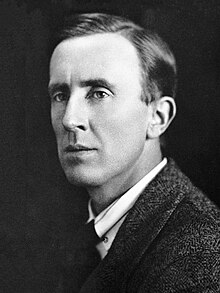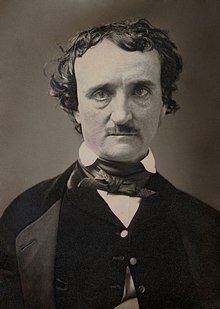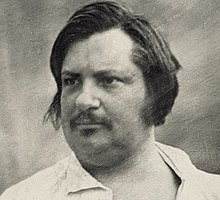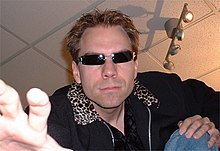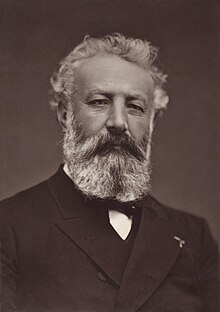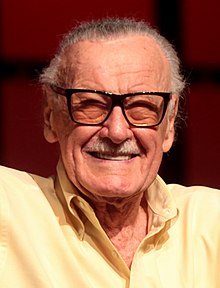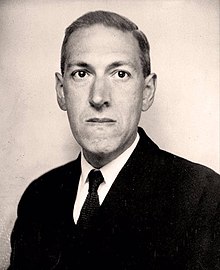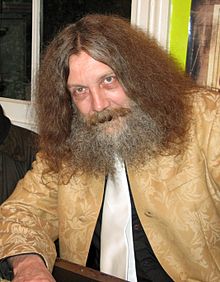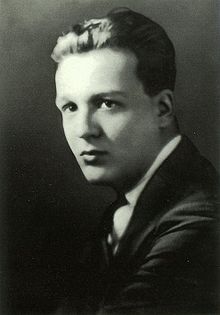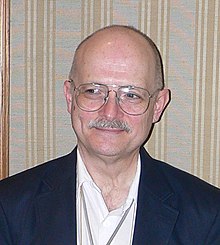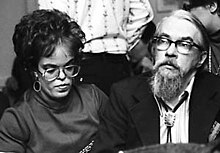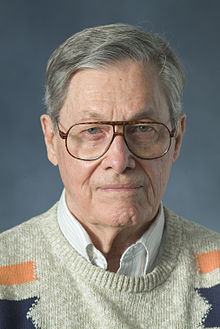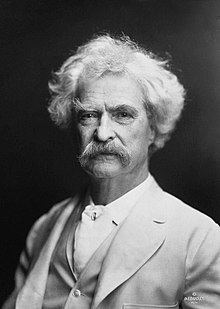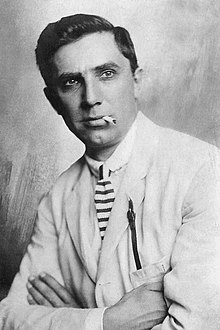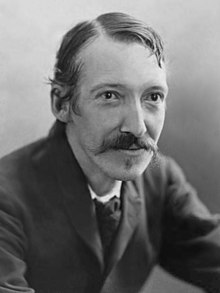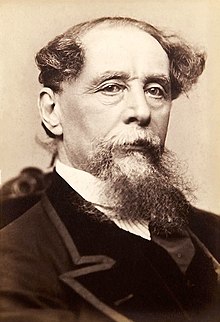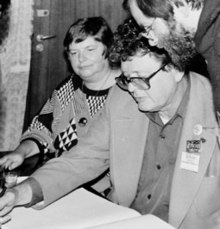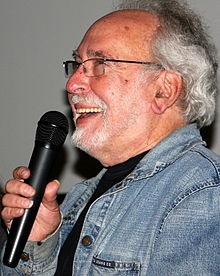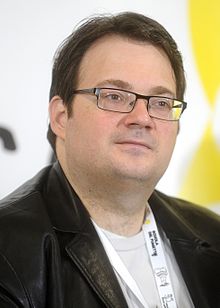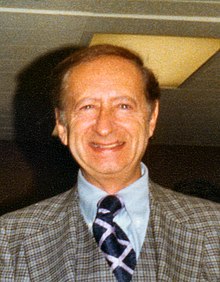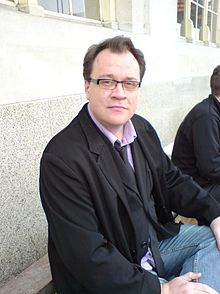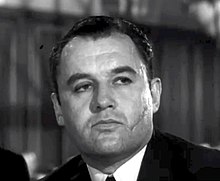Portal:Speculative fiction/Selected biography
This is a listing of all biographies for the
.
From 1925 to 1945, Tolkien was the
Alfred Tennyson, 1st Baron Tennyson FRS (/ˈtɛnɪsən/; 6 August 1809 – 6 October 1892) was an English poet. He was the Poet Laureate during much of Queen Victoria's reign. In 1829, Tennyson was awarded the Chancellor's Gold Medal at Cambridge for one of his first pieces, "Timbuktu". He published his first solo collection of poems, Poems, Chiefly Lyrical, in 1830. "Claribel" and "Mariana", which remain some of Tennyson's most celebrated poems, were included in this volume. Although described by some critics as overly sentimental, his verse soon proved popular and brought Tennyson to the attention of well-known writers of the day, including Samuel Taylor Coleridge. Tennyson's early poetry, with its medievalism and powerful visual imagery, was a major influence on the Pre-Raphaelite Brotherhood.
Tennyson also excelled at short lyrics, such as "Break, Break, Break", "The Charge of the Light Brigade", "Tears, Idle Tears", and "Crossing the Bar". Much of his verse was based on classical mythological themes, such as "Ulysses". "In Memoriam A.H.H." was written to commemorate his friend Arthur Hallam, a fellow poet and student at Trinity College, Cambridge, after he died of a stroke at the age of 22. Tennyson also wrote some notable blank verse including Idylls of the King, "Ulysses", and "Tithonus". During his career, Tennyson attempted drama, but his plays enjoyed little success. (Full article...)
Poe was born in
After expanding on the story in Neuromancer with two more novels (
William Denby Hanna (July 14, 1910 – March 22, 2001) was an American animator, voice actor, and occasional musician who is best known for co-creating Tom and Jerry and providing the vocal effects for the series' title characters. Alongside Joseph Barbera, he also founded the animation studio and production company Hanna-Barbera.
Hanna joined the
Mary's mother died 11 days after giving birth to her. She was raised by her father, who provided her with a rich if informal education, encouraging her to adhere to his own
Joanne Rowling
Born in Yate, Gloucestershire, Rowling was working as a researcher and bilingual secretary for Amnesty International in 1990 when she conceived the idea for the Harry Potter series. The seven-year period that followed saw the death of her mother, the birth of her first child, divorce from her first husband, and relative poverty until the first novel in the series, Harry Potter and the Philosopher's Stone, was published in 1997. Six sequels followed, concluding with Harry Potter and the Deathly Hallows (2007). By 2008, Forbes had named her the world's highest-paid author. (Full article...)
Owing to his keen observation of detail and unfiltered representation of society, Balzac is regarded as one of the founders of
He lives in
Kepler was a mathematics teacher at a seminary school in Graz, where he became an associate of Prince Hans Ulrich von Eggenberg. Later he became an assistant to the astronomer Tycho Brahe in Prague, and eventually the imperial mathematician to Emperor Rudolf II and his two successors Matthias and Ferdinand II. He also taught mathematics in Linz, and was an adviser to General Wallenstein.
Additionally, he did fundamental work in the field of optics, being named the father of modern optics, in particular for his Astronomiae pars optica. He also invented an improved version of the refracting telescope, the Keplerian telescope, which became the foundation of the modern refracting telescope, while also improving on the telescope design by Galileo Galilei, who mentioned Kepler's discoveries in his work. (Full article...)
Robert Ervin Howard (January 22, 1906 – June 11, 1936) was an American writer who wrote pulp fiction in a diverse range of genres. He created the character Conan the Barbarian and is regarded as the father of the sword and sorcery subgenre.
Howard was born and raised in Texas. He spent most of his life in the town of Cross Plains, with some time spent in nearby Brownwood. A bookish and intellectual child, he was also a fan of boxing and spent some time in his late teens bodybuilding, eventually taking up amateur boxing. From the age of nine he dreamed of becoming a writer of adventure fiction but did not have real success until he was 23. Thereafter, until his death by suicide at age 30, Howard's writings were published in a wide selection of magazines, journals, and newspapers, and he became proficient in several subgenres. His greatest success occurred after his death. (Full article...)
Ray Douglas Bradbury (US: /ˈbrædbɛri/ BRAD-berr-ee; August 22, 1920 – June 5, 2012) was an American author and screenwriter. One of the most celebrated 20th-century American writers, he worked in a variety of genres, including fantasy, science fiction, horror, mystery, and realistic fiction.
Bradbury is best known for his novel Fahrenheit 451 (1953) and his short-story collections The Martian Chronicles (1950), The Illustrated Man (1951), "The Veldt", and The October Country (1955). Other notable works include the coming of age novel Dandelion Wine (1957), the dark fantasy Something Wicked This Way Comes (1962) and the fictionalized memoir Green Shadows, White Whale (1992). He also wrote and consulted on screenplays and television scripts, including Moby Dick and It Came from Outer Space. Many of his works were adapted into television and film productions as well as comic books. Bradbury also wrote poetry which has been published in several collections, such as They Have Not Seen the Stars (2001). (Full article...)
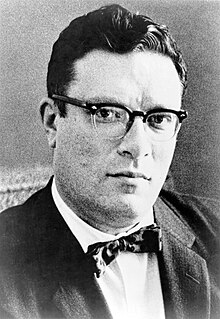
Isaac Asimov (/ˈæzɪmɒv/ AZ-ih-mov; c. January 2, 1920 – April 6, 1992) was an American writer and professor of biochemistry at Boston University. During his lifetime, Asimov was considered one of the "Big Three" science fiction writers, along with Robert A. Heinlein and Arthur C. Clarke. A prolific writer, he wrote or edited more than 500 books. He also wrote an estimated 90,000 letters and postcards. Best known for his hard science fiction, Asimov also wrote mysteries and fantasy, as well as popular science and other non-fiction.
Asimov's most famous work is the

Paul Myron Anthony Linebarger (July 11, 1913 – August 6, 1966), better known by his pen-name Cordwainer Smith, was an American author known for his science fiction works. Linebarger was a US Army officer, a noted East Asia scholar, and an expert in psychological warfare. Although his career as a writer was shortened by his death at the age of 53, he is considered one of science fiction's more talented and influential authors. (Full article...)
Alfred Bester (December 18, 1913 – September 30, 1987) was an American science fiction author, TV and radio scriptwriter, magazine editor and scriptwriter for comics. He is best remembered for his science fiction, including The Demolished Man, winner of the inaugural Hugo Award in 1953. Science fiction author Harry Harrison wrote, "Alfred Bester was one of the handful of writers who invented modern science fiction." (Full article...)
Lem was the author of the fundamental philosophical work
John Wood Campbell Jr. (June 8, 1910 – July 11, 1971) was an American science fiction writer and editor. He was editor of Astounding Science Fiction (later called Analog Science Fiction and Fact) from late 1937 until his death and was part of the Golden Age of Science Fiction. Campbell wrote super-science space opera under his own name and stories under his primary pseudonym, Don A. Stuart. Campbell also used the pen names Karl Van Kampen and Arthur McCann. His novella Who Goes There? was adapted as the films The Thing from Another World (1951), The Thing (1982), and The Thing (2011).
Campbell began writing science fiction at age 18 while attending MIT. He published six short stories, one novel, and eight letters in the science fiction magazine Amazing Stories from 1930 to 1931. This work established Campbell's reputation as a writer of space adventure. When in 1934 he began to write stories with a different tone, he wrote as Don A. Stuart. From 1930 until 1937, Campbell was prolific and successful under both names; he stopped writing fiction shortly after he became editor of Astounding in 1937. (Full article...)

He co-wrote the screenplay for the 1968 film
Heinlein became one of the first American science-fiction writers to break into mainstream magazines such as
Jules Gabriel Verne (/vɜːrn/; French: [ʒyl ɡabʁijɛl vɛʁn]; 8 February 1828 – 24 March 1905) was a French novelist, poet, and playwright. His collaboration with the publisher Pierre-Jules Hetzel led to the creation of the Voyages extraordinaires, a series of bestselling adventure novels including Journey to the Center of the Earth (1864), Twenty Thousand Leagues Under the Seas (1870), and Around the World in Eighty Days (1872). His novels, always well documented, are generally set in the second half of the 19th century, taking into account the technological advances of the time.
In addition to his novels, he wrote numerous plays, short stories, autobiographical accounts, poetry, songs, and scientific, artistic, and literary studies. His work has been adapted for film and television since the beginning of cinema, as well as for comic books, theater, opera, music and video games. (Full article...)
Herbert George Wells (21 September 1866 – 13 August 1946) was an English writer. Prolific in many genres, he wrote more than fifty novels and dozens of short stories. His non-fiction output included works of social commentary, politics, history, popular science, satire, biography, and autobiography. Wells' science fiction novels are so well regarded that he has been called the "father of science fiction".
In addition to his fame as a writer, he was prominent in his lifetime as a forward-looking, even prophetic
, "Dean Swift".
Swift is remembered for works such as A Tale of a Tub (1704), An Argument Against Abolishing Christianity (1712), Gulliver's Travels (1726), and A Modest Proposal (1729). He is regarded by the Encyclopædia Britannica as the foremost prose satirist in the English language. He originally published all of his works under pseudonyms—such as Lemuel Gulliver, Isaac Bickerstaff, M. B. Drapier—or anonymously. He was a master of two styles of satire, the Horatian and Juvenalian styles. (Full article...)
Aldous Leonard Huxley (/ˈɔːldəs/ AWL-dəs; 26 July 1894 – 22 November 1963) was an English writer and philosopher. His bibliography spans nearly 50 books, including novels and non-fiction works, as well as essays, narratives, and poems.
Born into the prominent
Stan Lee (born Stanley Martin Lieber /ˈliːbər/; December 28, 1922–November 12, 2018) was an American comic book writer, editor, publisher and producer. He rose through the ranks of a family-run business called Timely Comics which would later become Marvel Comics. He was Marvel's primary creative leader for two decades, leading its expansion from a small division of a publishing house to a multimedia corporation that dominated the comics and film industries.
In collaboration with others at Marvel—particularly co-writers and artists
Howard Phillips Lovecraft (US: /ˈlʌvkræft/, UK: /ˈlʌvkrɑːft/; August 20, 1890 – March 15, 1937) was an American writer of weird, science, fantasy, and horror fiction. He is best known for his creation of the Cthulhu Mythos.
Born in Providence, Rhode Island, Lovecraft spent most of his life in New England. After his father's institutionalization in 1893, he lived affluently until his family's wealth dissipated after the death of his grandfather. Lovecraft then lived with his mother, in reduced financial security, until her institutionalization in 1919. He began to write essays for the United Amateur Press Association, and in 1913 wrote a critical letter to a pulp magazine that ultimately led to his involvement in pulp fiction. He became active in the speculative fiction community and was published in several pulp magazines. Lovecraft moved to New York City, marrying Sonia Greene in 1924, and later became the center of a wider group of authors known as the "Lovecraft Circle". They introduced him to Weird Tales, which became his most prominent publisher. Lovecraft's time in New York took a toll on his mental state and financial conditions. He returned to Providence in 1926 and produced some of his most popular works, including The Call of Cthulhu, At the Mountains of Madness, The Shadow over Innsmouth, and The Shadow Out of Time. He remained active as a writer for 11 years until his death from intestinal cancer at the age of 46. (Full article...)
Moore started writing for British underground and alternative fanzines in the late 1970s before achieving success publishing comic strips in such magazines as 2000 AD and Warrior. He was subsequently picked up by DC Comics as "the first comics writer living in Britain to do prominent work in America", where he worked on major characters such as Batman (Batman: The Killing Joke) and Superman ("Whatever Happened to the Man of Tomorrow?"), substantially developed the character Swamp Thing, and penned original titles such as Watchmen. During that decade, Moore helped to bring about greater social respectability for comics in the United States and United Kingdom. He prefers the term "comic" to "graphic novel". In the late 1980s and early 1990s he left the comic industry mainstream and went independent for a while, working on experimental work such as the epic From Hell and the prose novel Voice of the Fire. He subsequently returned to the mainstream later in the 1990s, working for Image Comics, before developing America's Best Comics, an imprint through which he published works such as The League of Extraordinary Gentlemen and the occult-based Promethea. In 2016, he published Jerusalem: a 1,266-page experimental novel set in his hometown of Northampton, UK. (Full article...)
Eric Arthur Blair (25 June 1903 – 21 January 1950) was an English novelist, poet, essayist, journalist, and critic who wrote under the pen name of George Orwell. His work is characterised by lucid prose, social criticism, opposition to totalitarianism, and support of democratic socialism.
Orwell produced literary criticism, poetry, fiction, and polemical journalism. He is known for the allegorical novella Animal Farm (1945) and the dystopian novel Nineteen Eighty-Four (1949). His non-fiction works, including The Road to Wigan Pier (1937), documenting his experience of working-class life in the industrial north of England, and Homage to Catalonia (1938), an account of his experiences soldiering for the Republican faction of the Spanish Civil War (1936–1939), are as critically respected as his essays on politics, literature, language and culture. (Full article...)
Initially an assistant professor at
Stanley Grauman Weinbaum (April 4, 1902 – December 14, 1935) was an American science fiction writer. His first story, "A Martian Odyssey", was published to great acclaim in July 1934; the alien Tweel was arguably the first character to satisfy John W. Campbell's challenge: "Write me a creature who thinks as well as a man, or better than a man, but not like a man." Weinbaum wrote more short stories and a few novels, but died from lung cancer less than a year and a half later. (Full article...)
Brian Wilson Aldiss
Greatly influenced by science fiction pioneer
Lessing was awarded the 2007 Nobel Prize in Literature. In awarding the prize, the Swedish Academy described her as "that epicist of the female experience, who with scepticism, fire and visionary power has subjected a divided civilisation to scrutiny". Lessing was the oldest person ever to receive the Nobel Prize in Literature, at age 87. (Full article...)

Born in Pasadena, California, Butler was raised by her widowed mother. Extremely shy as a child, Butler found an outlet at the library reading fantasy, and in writing. She began writing science fiction as a teenager. Butler attended community college during the Black Power movement. While participating in a local writer's workshop, she was encouraged to attend the Clarion Workshop, then held in Pennsylvania, which focused on science fiction. (Full article...)
Dune is the best-selling science fiction novel of all time, and the series is a classic of the science-fiction
Stephenson's work explores mathematics, cryptography, linguistics, philosophy, currency, and the history of science. He also writes non-fiction articles about technology in publications such as Wired. He has written novels with his uncle, George Jewsbury ("J. Frederick George"), under the collective pseudonym Stephen Bury. (Full article...)
Algirdas Jonas "Algis" Budrys (January 9, 1931 – June 9, 2008) was a Lithuanian-American science fiction author, editor, and critic. He was also known under the pen names Frank Mason, Alger Rome in collaboration with Jerome Bixby, John A. Sentry, William Scarff, and Paul Janvier. In 1960, he authored Rogue Moon, a novel. (Full article...)
From about 1959 until 1969, Pohl edited Galaxy and its sister magazine If; the latter won three successive annual Hugo Awards as the year's best professional magazine. His 1977 novel Gateway won four "year's best novel" awards: the Hugo voted by convention participants, the Locus voted by magazine subscribers, the Nebula voted by American science-fiction writers, and the juried academic John W. Campbell Memorial Award. He won the Campbell Memorial Award again for the 1984 collection of novellas The Years of the City, one of two repeat winners during the first 40 years. For his 1979 novel Jem, Pohl won a U.S. National Book Award in the one-year category Science Fiction, and it was a finalist for three other year's best novel awards. He won four Hugo and three Nebula Awards, including receiving both for the 1977 novel Gateway. (Full article...)
Lester del Rey (June 2, 1915 – May 10, 1993) was an American science fiction author and editor. He was the author of many books in the juvenile Winston Science Fiction series, and the editor at Del Rey Books, the fantasy and science fiction imprint of Ballantine Books, along with his fourth wife Judy-Lynn del Rey. (Full article...)
Farmer is best known for his sequences of novels, especially the 
John Wyndham Parkes Lucas Beynon Harris (
Gunn was a professor emeritus of English and the founding director of the Center for the Study of Science Fiction, both at the University of Kansas. (Full article...)
Zenna Chlarson Henderson (November 1, 1917 – May 11, 1983) was an American elementary school teacher and science fiction and fantasy author. Her first story was published in The Magazine of Fantasy & Science Fiction in 1951. Her work is cited as pre-feminist, often featuring middle-aged women, children, and their relationships, but with stereotyped gender roles. Many of her stories center around human aliens called "The People", who have special powers. Henderson was nominated for a Hugo Award in 1959 for her novelette Captivity. Science fiction authors Lois McMaster Bujold, Orson Scott Card, Connie Willis, Dale Bailey, and Kathy Tyers have cited her as an influence on their work. (Full article...)
Lyon Sprague de Camp (/ˌspreɪɡdəˈkæmp/; November 27, 1907 – November 6, 2000) was an American author of science fiction, fantasy and non-fiction literature. In a career spanning 60 years, he wrote over 100 books, both novels and works of non-fiction, including biographies of other fantasy authors. He was a major figure in science fiction in the 1930s and 1940s. (Full article...)
Samuel Langhorne Clemens (November 30, 1835 – April 21, 1910), known by the pen name Mark Twain, was an American writer, humorist and essayist. He was praised as the "greatest humorist the United States has produced," with William Faulkner calling him "the father of American literature." His novels include The Adventures of Tom Sawyer (1876) and its sequel, Adventures of Huckleberry Finn (1884), with the latter often called the "Great American Novel." Twain also wrote A Connecticut Yankee in King Arthur's Court (1889) and Pudd'nhead Wilson (1894), and co-wrote The Gilded Age: A Tale of Today (1873) with Charles Dudley Warner.
Twain was raised in Hannibal, Missouri, which later provided the setting for both Tom Sawyer and Huckleberry Finn. He served an apprenticeship with a printer early in his career, and then worked as a typesetter, contributing articles to his older brother Orion Clemens' newspaper. Twain then became a riverboat pilot on the Mississippi River, which provided him the material for Life on the Mississippi (1883). Soon after, Twain headed west to join Orion in Nevada. He referred humorously to his lack of success at mining, turning to journalism for the Virginia City Territorial Enterprise. (Full article...)
Andersen's fairy tales, consisting of 156 stories across nine volumes, have been translated into more than 125 languages. They have become embedded in Western collective consciousness, accessible to children as well as presenting lessons of virtue and resilience in the face of adversity for mature readers. His most famous fairy tales include "The Emperor's New Clothes", "The Little Mermaid", "The Nightingale", "The Steadfast Tin Soldier", "The Red Shoes", "The Princess and the Pea", "The Snow Queen", "The Ugly Duckling", "The Little Match Girl", and "Thumbelina". His stories have inspired ballets, plays, and animated and live-action films. (Full article...)
Béla Ferenc Dezső Blaskó (Hungarian:
Lugosi began acting on the Hungarian stage in 1902. After playing in 172 productions in his native Hungary, Lugosi moved on to appear in Hungarian silent films in 1917. He had to suddenly emigrate to Germany after
Robert Louis Stevenson (born Robert Lewis Balfour Stevenson; 13 November 1850 – 3 December 1894) was a Scottish novelist, essayist, poet and travel writer. He is best known for works such as Treasure Island, Strange Case of Dr Jekyll and Mr Hyde, Kidnapped and A Child's Garden of Verses.
Born and educated in Edinburgh, Stevenson suffered from serious bronchial trouble for much of his life but continued to write prolifically and travel widely in defiance of his poor health. As a young man, he mixed in London literary circles, receiving encouragement from
Charles John Huffam Dickens (/ˈdɪkɪnz/; 7 February 1812 – 9 June 1870) was an English novelist and social critic who created some of the world's best-known fictional characters, and is regarded by many as the greatest novelist of the Victorian era. His works enjoyed unprecedented popularity during his lifetime and, by the 20th century, critics and scholars had recognised him as a literary genius. His novels and short stories are widely read today.
Born in Portsmouth, Dickens left school at age 12 to work in a boot-blacking factory when his father John was incarcerated in a debtors' prison. After three years, he returned to school before beginning his literary career as a journalist. Dickens edited a weekly journal for 20 years; wrote 15 novels, five novellas, hundreds of short stories and nonfiction articles; lectured and performed readings extensively; was an indefatigable letter writer; and campaigned vigorously for children's rights, education, and other social reforms. (Full article...)
Le Guin was born in
While working at
Two years later, she published a collection of her short stories,
Poul William Anderson (November 25, 1926 – July 31, 2001) was an American fantasy and science fiction author who was active from the 1940s until his death in 2001. Anderson also wrote historical novels. He was nominated seven times for the Hugo Award and five times for the Nebula Award. (Full article...)
Carolyn Janice Cherry (born September 1, 1942), better known by the pen name C. J. Cherryh, is an American writer of speculative fiction. She has written more than 80 books since the mid-1970s, including the Hugo Award–winning novels Downbelow Station (1981) and Cyteen (1988), both set in her Alliance–Union universe, and her Foreigner series. She is known for worldbuilding, depicting fictional realms with great realism supported by vast research in history, language, psychology, and archeology.
Cherryh (pronounced "Cherry") appended a silent "h" to her real name because her first editor,
Constance Elaine Trimmer Willis (born December 31, 1945), commonly known as
Several of her works feature time travel by history students at the future University of Oxford, called the Time Travel series or the Oxford Time Travel Series. They are the short story "Fire Watch" (1982, also in several anthologies and the 1985 collection of the same name), the novels Doomsday Book and To Say Nothing of the Dog (1992 and 1997), and the two-part novel Blackout/All Clear (2010). All four won the annual Hugo Award, and Doomsday Book and Blackout/All Clear won both the Hugo and Nebula Awards, making her the first author to win Hugo awards for all books in a series. (Full article...)
He created Sanderson's Laws of Magic and popularized the idea of "hard magic" and "soft magic" systems. In 2008, Sanderson started a podcast with author Dan Wells and cartoonist Howard Tayler called Writing Excuses, involving topics about creating genre writing and webcomics. In 2016, the American media company DMG Entertainment licensed the movie rights to Sanderson's entire Cosmere universe, but the rights have since reverted back to Sanderson. Sanderson's March 2022 Kickstarter campaign became the most successful in history, finishing with 185,341 backers pledging $41,754,153. (Full article...)
James Oliver Rigney Jr. (October 17, 1948 – September 16, 2007), better known by his pen name
Larry Correia (/kəˈriː.ə/; born 1977) is an American fantasy and science fiction writer, known for his Monster Hunter International, Grimnoir Chronicles, and Saga of the Forgotten Warrior series. He has authored or co-authored over 25 novels, has over 50 published short works, two collections of stories, and has co-edited three published anthologies.
He was nominated for the
Patrick Joseph McGoohan (/məˈɡuː.ən/; March 19, 1928 – January 13, 2009) was an American-born Irish actor, director, screenwriter, and producer of film, television, and theatre. Born in New York City to Irish parents, he was raised in Ireland and England, began his career in England during the 1950s and became well known for the titular role, secret agent John Drake in the ITC espionage programme Danger Man (1960–1968). He then produced and created The Prisoner (1967–1968), a surrealistic television series in which he featured as Number Six, an unnamed British intelligence agent who is abducted and imprisoned in a mysterious coastal village.
Beginning in the 1970s, McGoohan maintained a long-running association with the television series Columbo, writing, directing, producing and appearing in several episodes. His notable film roles included David Jones in Ice Station Zebra (1968), James Stewart, 1st Earl of Moray in Mary, Queen of Scots (1971), the Warden in Escape from Alcatraz (1979), Dr. Paul Ruth in Scanners (1981), King Edward I in Braveheart (1995), Judge Omar Noose in A Time to Kill (1996), and the voice of Billy Bones in Treasure Planet (2002). (Full article...)
Andrade was a central figure in the
Thomas Nigel Kneale (18 April 1922 – 29 October 2006) was a Manx screenwriter who wrote professionally for more than 50 years, was a winner of the Somerset Maugham Award, and was twice nominated for the BAFTA Award for Best British Screenplay
Sydney Cecil Newman OC (April 1, 1917 – October 30, 1997) was a Canadian film and television producer, who played a pioneering role in British television drama from the late 1950s to the late 1960s. After his return to Canada in 1970, Newman was appointed acting director of the Broadcast Programs Branch for the Canadian Radio and Television Commission (CRTC) and then head of the National Film Board of Canada (NFB). He also occupied senior positions at the Canadian Film Development Corporation and Canadian Broadcasting Corporation, and acted as an advisor to the Secretary of State.
During his time in Britain in the 1950s and 1960s, he worked first with
)In his early years, Stoker worked as a theatre critic for an Irish newspaper, and wrote stories as well as commentaries. He also enjoyed travelling, particularly to Cruden Bay in Scotland where he set two of his novels. During another visit to the English coastal town of Whitby, Stoker drew inspiration for writing Dracula. He died on 20 April 1912 due to locomotor ataxia and was cremated in north London. Since his death, his magnum opus Dracula has become one of the best-known works in English literature, and the novel has been adapted for numerous films, short stories, and plays. (Full article...)
A prolific and versatile writer, Bierce was regarded as one of the most influential journalists in the United States and as a pioneering writer of realist fiction. For his horror writing,
Bloch was a contributor to
Kurt Vonnegut (/ˈvɒnəɡət/ VON-ə-gət; November 11, 1922 – April 11, 2007) was an American writer and humorist known for his satirical and darkly humorous novels. He published 14 novels, three short-story collections, five plays, and five nonfiction works over fifty-plus years; further collections have been published since his death.
Born and raised in
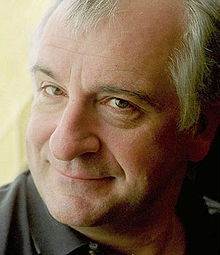
Adams also wrote
Stephen Russell Davies
Born in
Born in Chicago in 1901, Disney developed an early interest in drawing. He took art classes as a boy and took a job as a commercial illustrator at the age of 18. He moved to California in the early 1920s and set up the Disney Brothers Studio (now
Robert Earl Kaske (June 1, 1921 – August 8, 1989) was an American professor of medieval literature. He spent most of his career at Cornell University in Ithaca, New York, where he was the Avalon Foundation Professor in the Humanities, and where he founded one of the preeminent medieval studies graduate programs in North America. His published output included lengthy interpretations of Beowulf, and of poems and passages by Dante and Chaucer, and frequently constituted leading studies. Kaske particularly enjoyed solving cruxes, with articles on problematic passages in works such as Pearl, Piers Plowman, the Divine Comedy, "The Husband's Message", "The Descent into Hell", and Beowulf.
Born in Cincinnati and a straight-A student in high school, Kaske studied liberal arts at Xavier University and joined a variety of student literary organizations there. He was a four-year member of the Reserve Officers' Training Corps, and was commissioned a second lieutenant before his 1942 graduation; much of the next four years was spent with the Army in the South Pacific during World War II. While there he read a story about a dusk-to-dawn conversation between two professors and, entranced by the prospect of such intellectual discussions, decided on an academic career. Kaske enrolled in the English literature program at the University of North Carolina at Chapel Hill (UNC) on the back of the G.I. Bill, received his master's in 1947, and his PhD in 1950. (Full article...)
Rodney Stephen Steiger (/ˈstaɪɡər/ STY-gər; April 14, 1925 – July 9, 2002) was an American actor, noted for his portrayal of offbeat, often volatile and crazed characters. Ranked as "one of Hollywood's most charismatic and dynamic stars", he is closely associated with the art of method acting, embodying the characters he played, which at times led to clashes with directors and co-stars. He starred as Marlon Brando's mobster brother Charley in On the Waterfront (1954), the title character Sol Nazerman in The Pawnbroker (1964) which won him the Silver Bear for Best Actor, and as police chief Bill Gillespie opposite Sidney Poitier in the film In the Heat of the Night (1967) which won him the Academy Award for Best Actor.
Steiger was born in Westhampton, New York, the son of a vaudevillian. He had a difficult childhood, running away from home to escape an alcoholic mother at the age of 16. After serving in the South Pacific during World War II, he began his acting career with television roles in 1947, and went on to garner critical acclaim for his portrayal of the main character in the teleplay "Marty" (1953). He made his stage debut in 1946, in a production of Curse you, Jack Dalton! at the Civic Repertory Theatre of Newark, and subsequently appeared in productions such as An Enemy of the People (1950), Clifford Odets's Night Music (1951), Seagulls Over Sorrento (1952), and Rashomon (1959). (Full article...)
Nolan developed an interest in filmmaking from a young age. After studying English literature at University College London, he made several short films before his feature film debut with Following (1998). Nolan gained international recognition with his second film, Memento (2000), and transitioned into studio filmmaking with Insomnia (2002). He became a high-profile director with The Dark Knight trilogy (2005–2012), and found further success with The Prestige (2006), Inception (2010), Interstellar (2014), and Dunkirk (2017). After the release of Tenet (2020), Nolan parted ways with longtime distributor Warner Bros. Pictures, and signed with Universal Pictures for the biographical thriller Oppenheimer (2023), which won him Academy Awards for Best Director and Best Picture. (Full article...)
Thomas Stanley Holland (born 1 June 1996) is an English actor. His accolades include a British Academy Film Award and three Saturn Awards. He featured on the Forbes 30 Under 30 Europe list of 2019. Some publications have called him one of the most popular actors of his generation.
Holland's career began at age nine when he enrolled in a dancing class, where a choreographer noticed him and arranged for him to audition for a role in Billy Elliot the Musical at London's Victoria Palace Theatre. After two years of training, he secured a supporting part in 2008 and was upgraded to the title role that year, which he played until 2010. Holland made his film debut in the disaster drama The Impossible (2012) as a teenage tourist trapped in a tsunami, for which he received critical acclaim and a nomination for the Goya Award for Best New Actor. After this, Holland decided to pursue acting as a full-time career, appearing in How I Live Now (2013) and playing historical figures in the film In the Heart of the Sea (2015) and the miniseries Wolf Hall (2015). (Full article...)

Colin Robert Chase (February 5, 1935 – October 13, 1984) was an American academic. An associate professor of English at the University of Toronto, he was known for his contributions to the studies of Old English and Anglo-Latin literature. His best-known work, The Dating of Beowulf, challenged the accepted orthodoxy of the dating of the Anglo-Saxon poem Beowulf—then thought to be from the latter half of the eighth century—and left behind what was described in A Beowulf Handbook as "a cautious and necessary incertitude".
Born in Denver, Chase was one of three sons of a newspaper executive and a Pulitzer Prize-winning playwright, Mary Coyle Chase. Chase's two brothers became actors; he considered such a career, but ultimately studied English literature, classics, and philosophy. He received his Bachelor of Arts from Harvard University, Master of Arts from Saint Louis and Johns Hopkins Universities, and Ph.D. from the University of Toronto in 1971, the same year the university named him an assistant professor. (Full article...)

